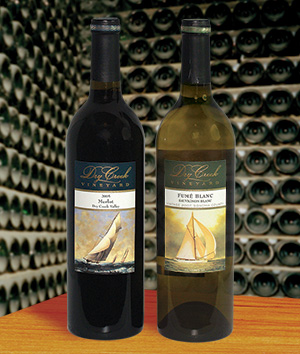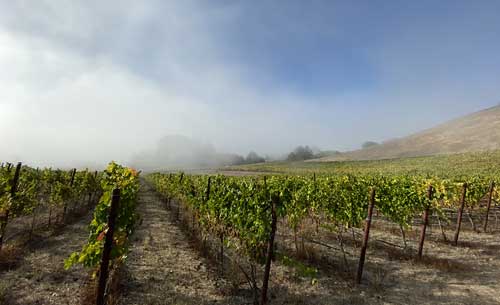 An American in Paris
An American in Paris
Steven Spurrier is an Englishman who once owned a wine shop in Paris that catered to the English-speaking expatriate community. In 1976, in order to drum up interest in his business, he hit upon the idea of holding a blind tasting pitting ten of France’s and California’s best producers against one another. He was able to enlist nine esteemed French wine experts as judges, among them Odette Kahn, editor of the influential Revue du Vin de France; and Christian Vannequé, sommelier of the three-star Parisian restaurant La Tour d’Argent. The French wines included the 1970 Haut-Brion, the 1970 Mouton Rothschild, and the 1973 Domaine Leflaive Puligny-Montrachet Les Pucelles.
The famous tasting, held May 24, 1976, at Paris’ InterContinental Hotel, has come to be known as The Judgement of Paris. Neither Spurrier, a Francophile to the core, nor anyone else expected the upstart Yanks to really put up a fight against the French heavyweights. However, when the votes were tallied, the judges were shocked to discover they had awarded the top prize for the red to the 1973 Stag’s Leap Wine Cellars Cabernet Sauvignon, and top prize for the white to Chateau Montelena Chardonnay, both from Napa Valley. It was the shock heard ‘round the world, and legitimized California as a world-class wine-making region.
George M. Taber, the Time magazine correspondent present at the time, details the event in Judgment of Paris: California vs. France and the Historic 1976 Paris Tasting That Revolutionized Wine. The story was also dramatized in the 2008 film Bottle Shock.
Thirty years later, in May of 2006, as a celebration of the original Judgement, the same wines were retasted to gauge their aging potential. The French were confident that here the weak Californians would stumble. Instead, mon dieu, they placed first through fifth. Boo Ya!
Chateau Montelena has seen three cycles of family stewardship. The first began in 1882 when the winery was founded by Alfred L. Tubbs, a European immigrant and San Fransciso entrepreneur. The original property was 254 acres of rugged, well drained, stony, and loose land just two miles north of Calistoga at the base of Mount Saint Helena. (Montelena is a contracted form of Mount Saint Helena.) By 1896 Tubbs’ winery was the seventh largest in the Napa Valley.
The Tubbs family sold the winery in 1958, at which time the Chateau and its overgrown grounds passed into the hands of Yort and Jeanie Frank, who were looking for a peaceful spot to retire. The setting inspired Frank to excavate a lake and add landscaping to reflect the Chinese gardens of his homeland.
The modern renaissance of Chateau Montelena started under the leadership of Jim Barrett, who purchased the winery in 1972. The vineyard was cleared and replanted, and the winery was renovated and outfitted with modern winemaking equipment, complemented by the highest-quality grapes from the Napa Valley. In 1972 wines were made for the first time, and shortly thereafter Chateau Montelena stunned the wine world with its win at the 1976 Paris Tasting. The winery continues today with Jim Barrett at the helm.
Napa Valley Chardonnay 2008
This Chardonnay started by being harvested at night in order to preserve delicate flavors and aromas. The wine is brilliantly clear with a golden-straw color. The nose suggests pear and tropical passion fruit. On the palate, there are flavors of juicy peach, citrus notes of pink grapefruit, honey tangerine, and starfruit, conveyed by an appealing softness. The mid-palate features an understated, nutty, oak tone which segues into an interesting long and spicy finish. The wine was aged for 10 months in 100% French barrels, 11% of which were new.
Serve this legendary wine with Morroccan Lemon Chicken, Sea Bass with Gingered Broth, Risotto with Scallops, or, if your dinner guests are French, Crow.
Napa Valley Cabernet 2006
Although famous for their Chardonnay, Montelena makes a number of reds as well, including this Cabernet Sauvignon. The blend is 88% Cabernet Sauvignon, 8% Merlot, and 4% Cabernet Franc.
Dark ruby in color, this wine offers rich, complex aromas of ripe dark cherry, plum, cinnamon, and tobacco, with top notes of earth and forest floor. In the mouth, this wine makes a full soft round entry, after which the acid builds nicely, supporting the dominant flavor of black currant, plus licorice and spice. Plenty of fine-grain tannin completes the mouthfeel. Nice notes of toasted oak round out the tremendous long finish. This is a very well-balanced wine that will age for ten to twelve years, if you have the patience.
Pair this Cabernet with Tenderloin of Beef with Blue Cheese, Cider-Braised Pork Medallions, or Broiled Lamb Chops.
montelena.com/
Back to blog posts: winervana.com/blog/
 Jeff Gordon (no, not that Jeff Gordon) is a fourth-generation farmer, born and raised in Washington state. Although tied to the land, Gordon realized early on that affection wasn’t enough, and was shrewd enough to take a Bachelor’s degree in Agriculture in 1971.
Jeff Gordon (no, not that Jeff Gordon) is a fourth-generation farmer, born and raised in Washington state. Although tied to the land, Gordon realized early on that affection wasn’t enough, and was shrewd enough to take a Bachelor’s degree in Agriculture in 1971.
 River’s Edge Winery is located in the northern-most part of the Umpqua Valley. River’s Edge, founded in 1998, specializes in the production of cool weather varieties such as pinot noir and gewürztraminer. The ocean is only 36 miles away from the winery, and morning fog frequently shrouds the vineyards even in the summer, reflecting the strong marine influence on the climate.
River’s Edge Winery is located in the northern-most part of the Umpqua Valley. River’s Edge, founded in 1998, specializes in the production of cool weather varieties such as pinot noir and gewürztraminer. The ocean is only 36 miles away from the winery, and morning fog frequently shrouds the vineyards even in the summer, reflecting the strong marine influence on the climate. “This weekend is not about me. It is about you. I’m gonna show you a good time. We’re gonna drink a lot of good wine. We’re gonna play some golf. We’re gonna eat some great food and enjoy the scenery and we are going to send you off in style, mon frere.” And so Miles and Jack set off on their most excellent adventure in Sideways, the 2004 film that by some accounts was single-handedly responsible for a 10% increase in sales of pinot noir.
“This weekend is not about me. It is about you. I’m gonna show you a good time. We’re gonna drink a lot of good wine. We’re gonna play some golf. We’re gonna eat some great food and enjoy the scenery and we are going to send you off in style, mon frere.” And so Miles and Jack set off on their most excellent adventure in Sideways, the 2004 film that by some accounts was single-handedly responsible for a 10% increase in sales of pinot noir. Between the Mountains
Between the Mountains The Donald
The Donald As you enter Sonoma county from the south on California 121, one of the first wineries you encounter is Cline Cellars, and there could hardly be a better introduction to the Carneros AVA.
As you enter Sonoma county from the south on California 121, one of the first wineries you encounter is Cline Cellars, and there could hardly be a better introduction to the Carneros AVA. In the 1970s, Portugese rosés such as Lancers and Mateus were the height of sophistication to many young wine drinkers: “It’s imported, and comes in a fun bottle!” With age comes wisdom, and these wines were eventually abandoned for the justifiably famous fortified wines of Portugal, Port and Madeira, produced by many ancient and famous houses.
In the 1970s, Portugese rosés such as Lancers and Mateus were the height of sophistication to many young wine drinkers: “It’s imported, and comes in a fun bottle!” With age comes wisdom, and these wines were eventually abandoned for the justifiably famous fortified wines of Portugal, Port and Madeira, produced by many ancient and famous houses. An American in Paris
An American in Paris A Christmas Souffle
A Christmas Souffle Up On Dry Creek
Up On Dry Creek Wine by Joe
Wine by Joe
 In the Douro valley of Portugal, home of true Port wines, only the finest years are declared as Vintages, the best of the best. The last declared vintage was 2017. (Remarkably, this followed the declared 2016. Back to back declarations are qute rare.)
In the Douro valley of Portugal, home of true Port wines, only the finest years are declared as Vintages, the best of the best. The last declared vintage was 2017. (Remarkably, this followed the declared 2016. Back to back declarations are qute rare.) Justin Time
Justin Time
